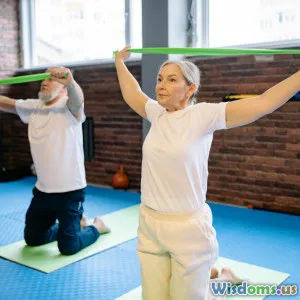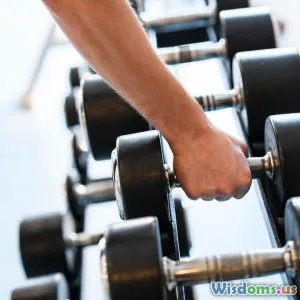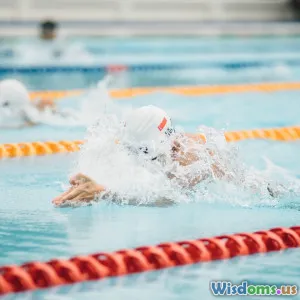
Comparing Recovery Time in Young Versus Older Endurance Athletes
17 min read Explore differences in recovery time between young and older endurance athletes, with insights into age-related factors and practical recovery strategies. (0 Reviews)
Recovery Time in Young Versus Older Endurance Athletes: A Deep Dive
Endurance athletics—spanning sports like running, cycling, and triathlon—demands continual performance and adaptation from the body. However, age significantly impacts how athletes recover after intense bouts. How does the recovery timeline differ between younger and older endurance competitors? What strategies can bridge the gap and extend athletic longevity? This article unpacks the science, athlete experiences, and actionable insights in the nuanced landscape of endurance recovery across the lifespan.
The Physiology of Recovery: Age Matters

Muscle tissue doesn’t distinguish between youth and age—at least not at first glance. But beneath the surface, the body’s response to exertion shifts markedly over time. After strenuous endurance activity, muscles embark on a process of repair involving inflammatory signals, protein synthesis, and tissue remodeling.
In young athletes, typically under 30 years old, these processes operate at peak efficiency, often aided by hormonal advantages such as elevated growth hormone and testosterone levels. Studies published in the Journal of Applied Physiology show that muscle protein synthesis can be elevated as much as 50% in the 24 hours post-exercise for younger subjects.
In contrast, older athletes—especially those over age 50—face a natural decline. For example, the rate of mitochondrial biogenesis (the restoration of energy-producing cell structures) slows with age. Additionally, the body’s antioxidant defenses typically weaken, contributing to prolonged muscle soreness and fatigue.
Case Study: At the 2022 Boston Marathon, amateur runners in the 20-29 bracket reported full muscle recovery within three days, while participants aged 50+ cited residual soreness and fatigue lasting up to a week.
The Impact of Inflammation and Repair

Intense endurance exercise creates micro-tears in muscle and connective tissues, inciting an inflammatory response—a necessary step for adaptation and growth. However, this response varies by age. Youthful athletes experience a rapid, localized spike in cytokines that tapers efficiently. Meanwhile, older adult athletes not only initiate a slower inflammatory response but often retain a heightened level of inflammation for longer.
A 2018 meta-analysis in Sports Medicine revealed that older male cyclists experienced elevated C-reactive protein (CRP, a major marker of inflammation) up to 48 hours longer post-event compared to their younger counterparts. This extended phase can hamper training frequency and increase the risk of overuse injuries such as tendonitis or stress fractures.
Furthermore, aging reduces satellite cell activity—crucial progenitor cells involved in muscle regeneration—making repair more laborious for senior athletes. As a result, coaches working with older endurance groups often recommend spacing intense sessions further apart, sometimes with double the recovery days allocated to younger competitors for a similar training stimulus.
Hormonal Variability and Cellular Recovery

Hormones orchestrate the symphony of physiological recovery. Testosterone, growth hormone, and IGF-1 (insulin-like growth factor) all play significant roles in muscle repair and metabolic recovery. With age, all three decline at a rate of roughly 1–2% per year beginning in the fourth decade of life.
This inevitable hormonal drop-off creates a compounding effect. An older triathlete faces not just a longer repair time but also struggles to rebuild tissue as robustly as in their youth. This was evident in a study comparing ironman triathletes: athletes aged 20–30 restored pre-race testosterone within 48 hours, while the 50–60 group required up to a week to reach baseline.
Strategies such as sleep optimization, nutrition-based interventions, and stress management have shown to partly buffer these age-related hormonal shifts, though they cannot entirely negate the fundamental timeline disparity.
Sleep: The Most Underestimated Recovery Tool

No discussion of athletic recovery is complete without addressing the role of sleep. Deep, slow-wave sleep is when the bulk of tissue repair and immune restoration occurs. Emerging evidence suggests age-related alterations in sleep architecture—in particular, reduced REM phases in adults over 50—impact the body’s ability to rapidly recover after taxing exercise.
Adolescent runners, for example, demonstrated significant improvements in next-day muscle function after sleeping 8 to 10 hours nightly—a practice common in collegiate track teams. Seniors, on the other hand, averaged less than 7 hours of fragmented sleep, correlating with prolonged post-race fatigue and muscle tenderness.
Actionable tip: Both demographics benefit from establishing consistent sleep routines, pitching their recovery windows for maximal tissue regeneration. For older athletes, adding brief daytime naps post-exercise helps offset diminished nighttime deep sleep.
Nourishing Recovery: Nutrition Across Decades

What you eat after training influences how swiftly you bounce back. Young athletes typically recover effectively with the traditional 3:1 carbohydrate-to-protein ratio within 30 minutes of activity. Their bodies efficiently digest, absorb, and shuttle nutrients to depleted muscle fibers.
Aging bodies, by contrast, display a dampened anabolic response to the same food intake—a phenomenon called "anabolic resistance." Research with master’s marathon runners demonstrates that older athletes require increased protein per meal (sometimes up to 40g) to trigger comparable muscle rebuilding. Timing is also more critical, as delaying food intake prolongs the recovery deficit.
Example: In the senior cycling community, it’s become standard to consume leucine-rich whey shakes and antioxidant-spiked fruits within 20 minutes of competition. By controlling for age-related reductions in digestion speed and muscle uptake, older athletes can narrow the recovery gap—though these interventions rarely fully compensate for biological changes.
Heart Rate Recovery: Vivid Differences by Age

One objective metric for gauging recovery is heart rate recovery (HRR)—the speed at which heart rate returns to pre-exercise norms. A rapid decrease, typically within two minutes post-exertion, signals swift parasympathetic (rest-and-digest) activation and is associated with robust cardiovascular health.
However, studies out of the European Journal of Preventive Cardiology found youth athletes regaining baseline heart rates up to 50% faster compared to their older peers after identical treadmill stress tests. Sluggish HRR in older athletes reflects both a decline in cardiac autonomic responsiveness and, often, cumulative cardiovascular wear.
Training adaptation: Coaches frequently use HRR benchmarks to tailor recovery days. For junior athletes, frequent high-intensity sessions are tenable because their cardiac systems rebound rapidly. Masters-level trainers program more extensive cooldowns and active recovery periods, working around a reliably slower HRR curve.
Injury Risks: Age-Driven Patterns

The matter of recovery transcends tempo—it’s also about outcomes. Young athletes enjoy not only faster tissue repair but also a lower incidence of chronic overuse injuries, provided proper technique and progression are observed. When injuries do occur, younger muscles and connective tissue typically re-integrate more completely and rapidly.
In contrast, the familiarity with injuries—tendon strains, stress reactions, or cartilage irritation—is arguably a rite of passage for seasoned competitors. According to the American Orthopaedic Society for Sports Medicine, runners over 50 report a 30% increased risk of injury compared to those in their twenties. Moreover, the recovery from such injuries is frequently protracted due to lower baseline cell turnover and hormonal support.
Preventive approaches: Age-aware training programs focus on cross-training, mobility maintenance, and graduating progression far more cautiously for older groups. This not only guards against tissue breakdown but also preserves motivation by limiting frustrating downtime.
Psychological Adaptation: Recovery Isn't Just Physical

Mental resilience, patience, and adaptability are equally significant yet less quantifiable facets of recovery. Athletes of all ages face the mental challenge of setbacks or lulls in progress. For youth, the frustration lies in constraint; for mature athletes, there is often a deeper reckoning with the limitations imposed by time.
Psychologists working with endurance athletes see a recurring pattern: young runners are more likely to "push through" soreness and fatigue, inadvertently risking overtraining. Older athletes, through experience or necessity, cultivate mindfulness, embrace structured rest, and establish routines that align ambitions with physiological reality.
Pro tip: Both demographics are encouraged to use recovery journals, objectively tracking progress, mood, and post-exercise sensations. This helps individualize the recovery process, closing the gap between biological and psychological response.
Optimizing Recovery Across the Ages: Practical Strategies

The recovery gaps between young and old are written into biology, yet smart interventions help mitigate them. Several strategies are especially crucial:
-
Active Recovery: Light movement—walking, gentle spinning, mobility drills the day after an event—can enhance circulation and expedite the removal of metabolic waste. Seasoned triathletes often schedule "easy days" after races, while young squads may need detection systems (like HR monitors) to signal when more rest is needed.
-
Hydration and Electrolyte Balance: Proper rehydration is vital for all, but older athletes are more prone to dehydration due to diminished thirst sensation. Weight-tracking pre/post-event or mineral supplementation may be necessary for age 50+ cohorts.
-
Massage and Foam Rolling: Self-myofascial release with foam rollers or massage guns aids both populations. Interestingly, a 2021 study revealed that older athletes experienced greater immediate post-massage reductions in perceived soreness compared to younger counterparts—possibly because baseline inflammation is higher in the former.
-
Cold/Hot Therapy: Efficacy of ice baths or hot/cold contrasting varies, but both have roles in curbing post-exercise swelling, especially for mature athletes who sustain greater tissue stress.
-
Deload Weeks: Regularly scheduled lower-intensity microcycles promote regeneration in both age groups, but masters athletes may require these more frequently to prevent chronic fatigue.
Quote: As renowned master marathoner Joan Benoit Samuelson notes, “Recovery is the one component you never outgrow—only your approach to it matures.”
The Role of Technology in Monitoring Recovery
In the modern athletic landscape, wearable devices—heart-rate monitors, Oura rings, sleep trackers—bring a new layer of precision to recovery tracking. For younger athletes, these tools reinforce discipline in tapering efforts and not chasing short-term progress. For older athletes, monitoring allows for swift adjustments before minor lags become layups for injuries.
Elite squads like the Nike Oregon Project and veteran Ironman clubs alike employ smartphone apps to visualize sleep debt, heart rate variability trends, and calorie surpluses or deficits. Continual feedback personalizes recovery schedules, making every day’s plan adaptive, evidence-driven, and sustainable well into the golden years.
Sustaining Performance and Enjoyment Throughout an Athletic Life

Regardless of age, every endurance athlete’s path is shaped as much by their recovery rhythms as their training milestones. While the reality of biology cannot be entirely sidestepped, a combination of science-driven adaptations, individualized care, and mental resilience bridges much of the gap between youth and wisdom.
From the nimble gaits of 18-year-old cross-country runners to the determined strides of septuagenarian marathoners, prioritizing recovery makes the journey more sustainable, rewarding, and safe. In the end, endurance isn’t just measured at the finish line—but in every step, day after day, that athletes devote to coming back stronger.
Rate the Post
User Reviews
Popular Posts

















